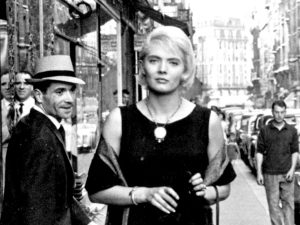With Cléo from 5 to 7 we are a long way from where we began the course, in the wreckage of 1945. But we are a long way from the 1950s as well. Agnes Varda’s film seems to speak to another moment in time, the consumerist paradise of the trente glorieuses, the bustling Paris of the 1960s, the new pop culture of the era, and to the personal and political dramas that ran just under the surface of this golden age.
Cléo (Florence) is a beautiful singer on the road to stardom. But this day, this afternoon, these hours from 5 to 7 she will spend waiting for the results of a medical test. Let’s just say that the Tarot cards don’t look promising.
The film was one of Varda’s masterpieces, among her many films that stretched from the 1950s until her last film in 2019, the year of her death, a body work that holds up to the best of the French New Wave (filmmakers like Truffaut, Godard, Resnais, etc.) She didn’t get the same acclaim as they did, at least until the end of her life.
What can Cléo’s story tell us? It is a picture of Paris before the student protests that would redefine “the Sixties.” It can be read as an existential drama – when our lives are full of plenty, where will we find meaning? It is the story of a woman (and of women) making a way for themselves despite the gender confines of 1960s France. What do you make of Cléo and her story? I look forward to hearing.

